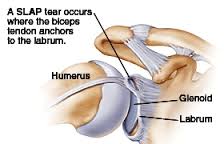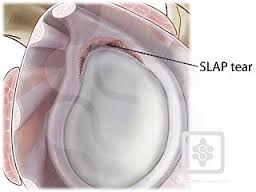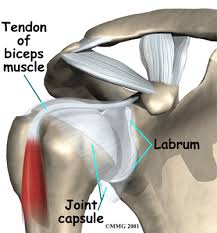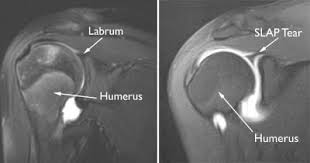SLAP Lesion: Difference between revisions
No edit summary |
No edit summary |
||
| Line 64: | Line 64: | ||
Arthroscopic SLAP Lesion (type 2) repair<br>Following inspection and determination of the extent of injury, the basic labrum repair is as follows. | Arthroscopic SLAP Lesion (type 2) repair<br>Following inspection and determination of the extent of injury, the basic labrum repair is as follows. | ||
The glenoid and labrum are roughened to increase contact surface area and promote re-growth.<br>Locations for the bone anchors are selected based on number and severity of tear. A severe tear involving both SLAP and Bankart lesions may require seven anchors. Simple tears may only require one.<br>The glenoid is drilled for the anchor implantation.<br>Anchors are inserted in the glenoid.<br>The suture component of the implant is tied through the labrum and knotted such that the labrum is in tight contact with the glenoid surface. | The glenoid and labrum are roughened to increase contact surface area and promote re-growth.<br>Locations for the bone anchors are selected based on number and severity of tear. A severe tear involving both SLAP and Bankart lesions may require seven anchors. Simple tears may only require one.<br>The glenoid is drilled for the anchor implantation.<br>Anchors are inserted in the glenoid.<br>The suture component of the implant is tied through the labrum and knotted such that the labrum is in tight contact with the glenoid surface. {{#ev:Youtube|https://www.youtube.com/watch?v=75ARVxXIRBE}} | ||
{{#ev: | |||
== Surgical Rehabilitation<br> == | == Surgical Rehabilitation<br> == | ||
Revision as of 07:15, 13 December 2016
Original Editor - Venugopal Pawar
Lead Editors
Clinically Relevant Anatomy
[edit | edit source]
A SLAP tear or SLAP lesion is an injury to the glenoid labrum (fibrocartilaginous rim attached around the margin of the glenoid cavity). SLAP is an acronym for "superior labral tear from anterior to posterior".
A SLAP tear or lesion occurs when there is damage to the superior (uppermost) area of the labrum. These lesions have come into public awareness because of their frequency in athletes involved in overhead and throwing activities in turn relating to relatively recent description of labral injuries in throwing athletes,[1] and initial definitions of the 4 (major) SLAP sub-types,[2] all happening since the 1990s. The identification and treatment of these injuries continues to evolve.
Mechanism of Injury / Pathological Process
[edit | edit source]
A SLAP Tear occurs if you get the tear at the end of The Biceps where it attaches to the Glenoid via the Labrum as shown in the above image. At the end of biceps attaches to the labrum which attaches to the glenoid. It serves as the anchor for biceps muscle, so it is very important for lifting things from the ground. Imagine a weight pulling down on your arm and rotatorcuff, biceps, and all other shoulder stabilizer muscles resisting that force and contracting to keep your arm from being pulled down.
They are like traction injuries where the arm is pulled suddenly from the socket.
Symptoms[edit | edit source]
Several symptoms are common but not specific:[3]
Dull, throbbing, ache in the joint which can be brought on by very strenuous exertion or simple household chores.
Difficulty sleeping due to shoulder discomfort. The SLAP lesion decreases the stability of the joint which, when combined with lying in bed, causes the shoulder to drop.
For an athlete involved in a throwing sport such as baseball, pain and a catching feeling are prevalent. Throwing athletes may also complain of a loss of strength or significant decreased velocity in throwing.
Any applied force overhead or pushing directly into the shoulder can result in impingement and catching sensations.
Diagnostic Procedures[edit | edit source]
Besides MRI, a through subjective and objective examination by a Physical therapist is important in identifying the likelyhood of a labral tear.
Investigations such as Ultrasound may help to exclude the presence of other injuries in shoulder.
Sometimes an MRI with contrast is recommended to see if there is a tear.
SubTypes[edit | edit source]
Although ten varieties of SLAP lesion have been described on MRI or MR arthrography[4] seven clinical types are generally described.[5]
Type I. Degenerative fraying of the superior portion of the labrum, with the labrum remaining firmly attached to the glenoid rim
Type II. Separation of the superior portion of the glenoid labrum and tendon of the biceps brachii muscle from the glenoid rim
Type III. Bucket-handle tears of the superior portion of the labrum without involvement of the biceps brachii (long head) attachment
Type IV. Bucket-handle tears of the superior portion of the labrum extending into the biceps tendon
Type V. Anteroinferior Bankart lesion that extends upward to include a separation of the biceps tendon
Type VI. Unstable radial flap tears associated with separation of the biceps anchor
Type VII. Anterior extension of the SLAP lesion beneath the middle glenohumeral ligament
Management / Interventions
[edit | edit source]
Non-operative Treatment:
[edit | edit source]
All patients should initially be managed with non-operative measures which include Physiotherapy, modification of activities, analgesics and sometimes steriod injections.
If these measures fail, then surgery may be considered.
Surgical Procedure: [edit | edit source]
Surgical treatment of SLAP tears has become more common in recent years. The success rate for repairing isolated SLAP tears is reported between 74-94%.[6] While surgery can be performed as a traditional open procedure, an arthroscopic technique[7] is currently favored being less intrusive with low chance of iatrogenic infection.[8]
Associated findings within the shoulder joint are varied, may not be predictable and include:
SLAP lesion – labrum/glenoid separation at the tendon of the biceps muscle
Bankart lesion – labrum/glenoid separation at the inferior glenohumeral ligament
Biceps Tendon - exclusion of pulley injury[9]
Bone – glenoid, humerus — injury or degenerative change involving joint surface
Anatomical variants — sublabral foramen, Buford Complex
It should be noted that while good outcomes with SLAP repair over the age of 40 are reported, both age greater than 40 and Workmen's Compensation status have been noted as independent predictors of surgical complications. This is particularly so if there is an associated rotator cuff injury. In such circumstances, it is suggested that labral debridement and biceps tenotomy is preferred.[10]
SLAP (Superior Labral Tear, Anterior to Posterior)
Type 1
Fraying of Superior Labrum
Biceps Anchor Intact
Type 2
Superior Labrum detached
Detachment of the Biceps Anchor
Type 3
Bucket Handle type tear of Superior Labrum
Biceps Anchor INTACT
Type 4
Bucket Handle tear of Superior Labrum
Extension of tear in Biceps Tendon
Part of Biceps Anchor still INTACT
Procedure[edit]
Arthroscopic SLAP Lesion (type 2) repair
Following inspection and determination of the extent of injury, the basic labrum repair is as follows.
The glenoid and labrum are roughened to increase contact surface area and promote re-growth.
Locations for the bone anchors are selected based on number and severity of tear. A severe tear involving both SLAP and Bankart lesions may require seven anchors. Simple tears may only require one.
The glenoid is drilled for the anchor implantation.
Anchors are inserted in the glenoid.
The suture component of the implant is tied through the labrum and knotted such that the labrum is in tight contact with the glenoid surface.
Surgical Rehabilitation
[edit | edit source]
Surgical rehabilitation is vital, progressive and supervised. The first phase focusses on early motion and usually occupies post-surgical weeks one through three. Passive range of motion is restored in the shoulder, elbow, forearm, and wrist joints. However, while manual resistance exercises for scapular protraction, elbow extension, and pronation and supination are encouraged, elbow flexion resistance is avoided because of the biceps contraction that it generates and the need to protect the labral repair for at least six weeks. A sling may be worn, as needed, for comfort. Phase 2, occupying weeks 4 through 6, involves progression of strength and range of motion, attempting to achieve progressive abduction and external rotation in the shoulder joint. Phase 3, usually weeks 6 through 10, permits elbow flexion resistive exercises, now allowing the biceps to come into play on the assumption that the labrum will have healed sufficiently to avoid injury. Thereafter, isokinetic exercises may be commenced from weeks 10 through 12 to 16, for advanced strengthening leading to return to full activity based on post surgical evaluation, strength, and functional range of motion. The periods of isokinetics through final clearance are sometimes referred to as phases four and five.[11]
Physical therapy [edit | edit source]
If you have suffered a labrum tear, your doctor may refer you to physical therapy. There, your physical therapist will evaluate and assess your current condition to help formulate a plan of care to treat your torn labrum
Acute labrum tears may be quite painful, and your physical therapist may provide you with treatments to control your pain. Heat or ice may be used, or electrical stimulation like TENS may be used to help decrease your pain. Caution should be used with passive modalities; many studies indicate that active involvement in your care is the best form of treatment.
Sometimes your shoulder becomes tight after an acute labrum tear. Your physical therapist may help you work on restoring normal range of motion (ROM) on your shoulder. Care should be taken not to be too aggressive here. A torn labrum usually causes your shoulder joint to be unstable, and aggressive ROM may cause your shoulder to come out of joint.
Since a torn labrum may cause your shoulder to be unstable, exercises to improve strength and stability around your shoulder are an essential part of your rehabilitation.
Exercise after a labrum tear may be required. Exercises to increase shoulder strength should focus on the muscles called the rotator cuff. These four muscles surround your shoulder and help to keep your shoulder in place when you move your arm. Strengthening the muscles around your shoulder blade and in your arm may also help to provide stability to your shoulder after a labrum tear.
Proprioception is your body's ability to recognize where it is in space. Exercises to improve the proprioception around your shoulder may be included in your treatment. Plyometric exercises may also be included in your rehabilitation program, especially if you are planning on returning to high-level sports and recreation.
After a labrum tear in your shoulder, you should expect to return to normal activity in about six to eight weeks. If you are not making progress with physical therapy, you may need more aggressive treatments like shoulder surgery to help correct your problem. Be sure to speak with your doctor about your condition to understand what to expect.
A shoulder labrum tear can be a painful injury that limits your ability to use your arm normally. It may cause your arm to feel weak and unstable. Physical therapy can help to increase the strength and mobility in your shoulder to help you return to normal activity quickly and safely.
Resources
[edit | edit source]
- 1) Andrews, JR; Carson WG, Jr; McLeod, WD (Sep–Oct 1985). "Glenoid labrum tears related to the long head of the biceps.". The American journal of sports medicine. 13 (5): 337–41. doi:10.1177/036354658501300508. PMID 4051091.
* 2) Jump up ^ Snyder, SJ; Karzel, RP; Del Pizzo, W; Ferkel, RD; Friedman, MJ (1990). "SLAP lesions of the shoulder.". Arthroscopy. 6 (4): 274–9. PMID 2264894.
- 3) Chang D, Mohana-Borges A, Borso M, Chung CB (Oct 2008). "SLAP lesions: anatomy, clinical presentation, MR imaging diagnosis and characterization". Eur J Radiol. 68 (1): 72–87. doi:10.1016/j.ejrad.2008.02.026. PMID 18499376.
- 4) Mohana-Borges AV, Chung CB, Resnick D (December 2003). "Superior labral anteroposterior tear: classification and diagnosis on MRI and MR arthrography". AJR Am J Roentgenol. 181 (6): 1449–62. doi:10.2214/ajr.181.6.1811449. PMID 14627555.
- 5) Aydin N, Sirin E, Arya A (Jul 18, 2014). "Superior labrum anterior to posterior lesions of the shoulder: Diagnosis and arthroscopic management". World J Orthop. 5 (3): 344–50. doi:10.5312/wjo.v5.i3.344. PMID 25035838.
- 6) Patterson BM, Creighton RA, Spang JT, Roberson JR, Kamath GV (Jun 2, 2014). "Surgical Trends in the Treatment of Superior Labrum Anterior and Posterior Lesions of the Shoulder: Analysis of Data From the American Board of Orthopaedic Surgery Certification Examination Database". Am J Sports Med. 42 (8): 1904–10. doi:10.1177/0363546514534939. PMID 24890780.
- 7) Huri G, Hyun YS, Garbis NG, McFarland EG (2014). "Treatment of superior labrum anterior posterior lesions: a literature review". Acta Orthop Traumatol Turc. 48 (3): 290–7. doi:10.3944/AOTT.2014.3169. PMID 24901919.
- 8) Babcock HM, Matava MJ, Fraser V (Jan 1, 2002). "Postarthroscopy surgical site infections: review of the literature". Clin Infect Dis. 34 (1): 65–71. doi:10.1086/324627. PMID 11731947.
- 9) Patzer T, Kircher J, Lichtenberg S, Sauter M, Magosch P, Habermeyer P (May 2011). "Is there an association between SLAP lesions and biceps pulley lesions?". Arthroscopy. 27 (5): 611–8. doi:10.1016/j.arthro.2011.01.005. PMID 21663718.
- 10) Erickson J, Lavery K, Monica J, Gatt C, Dhawan A (Jun 24, 2014). "Surgical Treatment of Symptomatic Superior Labrum Anterior-Posterior Tears in Patients Older Than 40 Years: A Systematic Review". Am J Sports Med. doi:10.1177/0363546514536874. PMID 24961444.
- 11) Ellenbecker TS, Sueyoshi T, Winters M, Zeman D (May 2008). "Descriptive report of shoulder range of motion and rotational strength six and 12 weeks following arthroscopic superior labral repair". N Am J Sports Phys Ther. 3 (2): 95–106. PMID 21509132.
Case Studies[edit | edit source]
add links to case studies here (case studies should be added on new pages using the case study template)
Recent Related Research (from Pubmed)[edit | edit source]
Extension:RSS -- Error: Not a valid URL: Feed goes here!!|charset=UTF-8|short|max=10
References[edit | edit source]
https://www.verywell.com/physical-therapy-after-a-shoulder-labrum-tear-2696539










